Digital Poster
Preclinical Body MRI: Liver, Pancreas & Kidney
ISMRM & ISMRT Annual Meeting & Exhibition • 10-15 May 2025 • Honolulu, Hawai'i

|
Computer Number:
1801. WITHDRAWN |
||
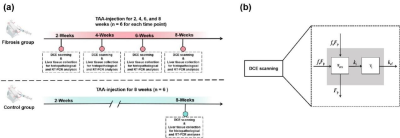 |
Computer Number: 145
1802. Assessing
liver function and liver fibrosis with the dual-input
dual-compartmental uptake and efflux model based on DCE-MRI: a
rat model study
Y. Guo, T. Guo, P. Sun, Z. Jin, F. Yang, X. Li
Department of Radiology, Union Hospital, Tongji Medical College, Huazhong University of Science and Technology, Wuhan, China
Impact: Our findings suggested that the parameters
derived from the dual-input dual-compartmental uptake and
efflux model were useful for assessing liver function and
simultaneously evaluating the degree of liver fibrosis.
|
|
 |
Computer Number: 146
1803. Liver
pH imaging for diagnosis and prognosis
J. Gois Santana, S. Kurdi, J. Chapiro, F. Hyder, D. Coman
Yale University, New Haven, United States
Impact: This study validates high-resolution pHe imaging
in mouse liver tumors using RESEGAW, enabling precise,
noninvasive metabolic characterization. By mapping pHe at
0.6 mm isotropic resolution, it advances understanding of
TME acidity and immune dynamics, potentially guiding liver
cancer therapies.
|
|
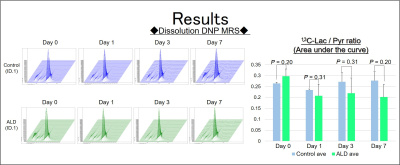 |
Computer Number: 147
1804. Verification
of redox and pyruvate metabolic changes using hyperpolarized MRI
in early alcohol-related liver disease model mice
T. Kaga, F. Hyodo, A. Elhelaly, Y. Noda, H. Kato, M. Matsuo
Gifu university, Gifu city, Japan
Impact: This study lays groundwork for the future
investigations to detect reversible/irreversible points of
fibrosis in chronic ALD using hyperpolarized MRI as an
imaging marker.
|
|
 |
Computer Number: 148
1805. Histological
validation of T1ρ mapping for liver fibrosis assessment in
animal models of non-alcoholic fatty liver disease: a
preclinical study
N. Mesropyan, F. Schneider, C. Katemann, O. Weber, J.
Luetkens, J. Chang, A. Isaak
University Hospital Bonn, Bonn, Germany
Impact: NAFLD patients with NASH and advanced fibrosis
are at increased risk of adverse outcomes. Early detection
and follow-up are paramount. T1ρ has the potential to
overcome the limitations of conventional mapping and become
a reliable biomarker for liver fibrosis quantification.
|
|
 |
Computer Number: 149
1806. Sex-specific
oxidative stress variations in healthy young rats and changes
linked to hepatic encephalopathy: New look into disease
mechanisms
K. Pierzchala, J. Mosso
CIBM Center for Biomedical Imaging, Lausanne, Switzerland, Lausanne, Switzerland
Impact: Little is known about sex differences in
reactive oxygen species (ROS)/antioxidants homeostasis. Here
for a first time we’ve demonstrated a significant sex
related difference in the concentration of basal brain ROS
and antioxidants followed by distinct changes while disease
progression.
|
|
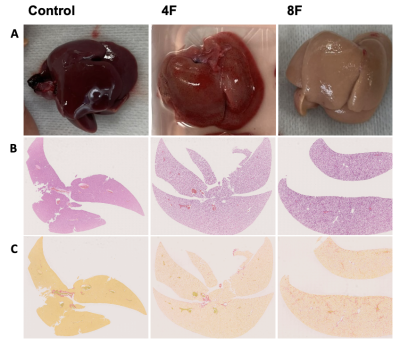 |
Computer Number: 150
1807. Evaluating
Inflammation and Fibrosis Without Fat Influence in Metabolic
Dysfunction-Associated Fatty Liver Disease: Pathological and
Radiological Correlation in Rats
K. Okumura, N. Ono, A. Kitao, K. Kozaka, X. SUN, H.
Yamauchi, S. Kobayashi
Kanazawa University, Kanazawa, Japan
Impact: In metabolic dysfunction-associated fatty liver
disease, fat-corrected T₁ values vary in response to the
levels of inflammation and fibrosis rather than fat.
Therefore, fat-corrected T₁ values may be useful in
distinguishing simple fatty liver from fatty hepatitis or
predicting of prognosis.
|
|
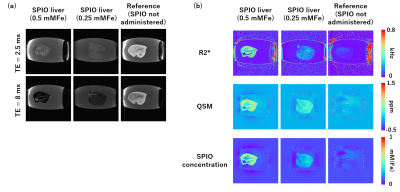 |
Computer Number: 151
1808. Quantitative
susceptibility mapping of ex vivo rat livers at high resolution
H. Nakamura, M. Yamaguchi, Y. Terada
Institute of Applied Physics, University of Tsukuba, Tsukuba, Japan
Impact: We quantified the SPIO concentration in rat
liver by QSM at high resolution. This is expected to lead to
a quantitative evaluation of radiotherapy margins for
hepatocellular carcinoma.
|
|
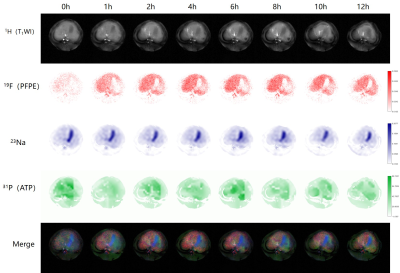 |
Computer Number: 152
1809. Simulcast
X-nuclei Magnetic Resonance Imaging for Pathological Dynamics of
Immune-Related Hepatitis in Rabbit
K. Wang, C. Yang, C. Wu, J. Yuan, L. Hu, X. Sun
NHC and CAMS Key Laboratory of Molecular Probe and Targeted Theranostics, Molecular Imaging Research Center (MIRC) of Harbin Medical University, Harbin, China
Impact: This work highlights the potential of simulcast
X-nuclei MRI in early detection and management of
immune-related hepatitis.
|
|
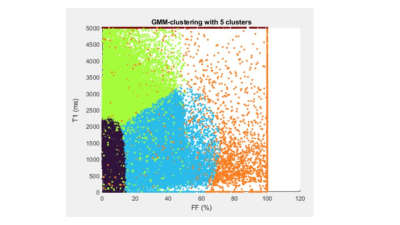 |
Computer Number: 153
1810. Advanced
Multiparametric and [19F] MRI for Non-Invasive Assessment of
Diet-Induced Liver Disease Progression in MAFLD and ALD
K. Samadikhah, A. Schmid
Werner Siemens Imaging Centre, Tuebingen, Germany
Impact: This study demonstrates the potential of
multiparametric and [19F] MRI with PFC for non-invasive,
quantitative analysis of diet-induced liver disease,
revealing detailed insights into liver inflammation,
fibrosis, and disease heterogeneity. This approach could
inform targeted therapies and enhance translational
relevance.
|
|
 |
Computer Number: 154
1811. Diagnosing
Metabolic-Associated Fatty Liver Disease in Experimental Rats
Using Various Diffusion-Weighted MRI Models
Y. Zhang, S. Xie, X. Du, X. Wang, J. Qin, J. Yang, J. Zhu,
O. Darwish, W. Shen
First Central Clinical College, Tianjin Medical University, Tianjin, China
Impact: This
research highlights the enhanced diagnostic precision of
diffusion-weighted MRI for MASH, exceeding the precision of
conventional methods. These findings provide a basis for
studies regarding early intervention strategies and may lead
to refined diagnostic protocols for liver disease severity.
|
|
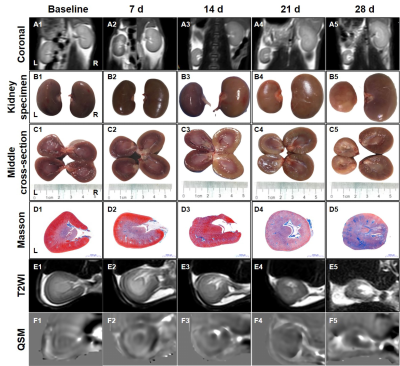 |
Computer Number: 155
1812. Evaluating
the potential of quantitative susceptibility mapping for
detecting iron deposition in a rabbit model of renal fibrosis
T. Zha, W. Xing, J. Chen, L. Pan, P. Wu
First People's Hospital of Changzhou, Changzhou, China
Impact: Different distributions of iron deposition
between the cortex and medulla contribute to different QSM
values, raising new possibilities in QSM applications for
detecting iron deposition in RF. QSM offers a supplementary
and promising imaging marker for evaluating RF.
|
|
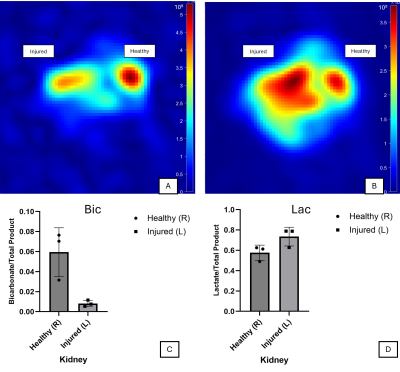 |
Computer Number: 156
1813. Imaging
aberrant oxidative and gluconeogenic metabolism in acute kidney
injury using hyperpolarized [1-13C]pyruvate and
[1,4-13C2]fumarate
S. N. G. Wathukara Dewage, S-H Lin, M. Huynh, Z. Erfani, X.
Wen, Z. Kovacs, J. M. Park
University of Texas Southwestern Medical Center , Dallas, United States
Impact: The
proposed imaging methods and biomarkers can be broadly
applicable to other types of tissue injuries, as well as
renal or hepatic diseases that affect metabolism.
|
|
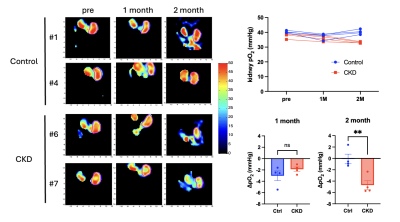 |
Computer Number: 157
1814. EPR
oximetry with Ox071 detects renal hypoxia in cisplatin-induced
chronic kidney disease models
K. Horie, S. Kishimoto, M. Horikawa, N. Koyasu, K. Yamamoto,
J. Brender, N. Devasahayam, M. Cherukuri
NCI, Bethesda, United States
Impact: Traditionally, EPR oximetry has concentrated on
tumor hypoxia due to Ox063’s limitations in well-oxygenated
tissues. Using Ox071, a deuterated analog, this research
broadens the application of oximetry to kidneys, where
hypoxic changes serve as a critical indicator of fibrosis.
|
|
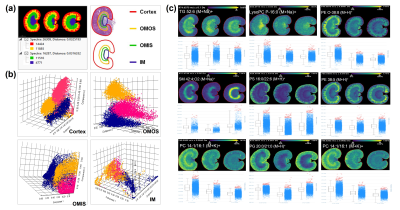 |
Computer Number: 158
1815. Combining
IDEAL-IQ sequence and MALDI mass spectrometry imaging technology
for the precise diagnosis of acute kidney injury.
Z. Huayv, Z. Huifang, J. Guo, Z. Ruiping
Shanxi Provincial People's Hospital, Taiyuan, China
Impact: It is of great significance for the clinical
prevention, precise diagnosis, and effective treatment of
acute kidney injury.
|
|
 |
Computer Number: 159
1816. Quantitative
study of R2 'Mapping to evaluate the effect of remote ischemic
preconditioning
Z. Bi, L. Pan, W. Xing
The First People's Hospital of Changzhou(The Third Affiliated Hospital of Soochow University), Changzhou, China
Impact: To provide a non-invasive MRI technique for
quantitative evaluation of RIPC effect in clinic
|
The International Society for Magnetic Resonance in Medicine is accredited by the Accreditation Council for Continuing Medical Education to provide continuing medical education for physicians.